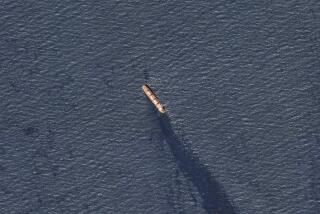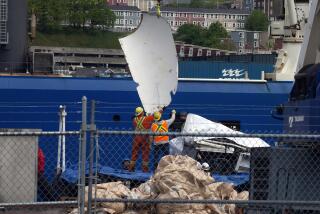Ehime Maru in Shallow Water for Diver Search
HONOLULU — The sunken wreckage of a Japanese fishing vessel was towed Sunday to a shallow-water recovery site where divers will search for the bodies of nine men and boys who went down with the ship when it was rammed by a Navy submarine.
The Rockwater 2 oil rigger set out early Friday to move the Ehime Maru 16 miles from its resting place in 2,000 feet of water to the site a mile offshore of Honolulu International Airport.
The fisheries training ship was rammed by the submarine Greeneville on Feb. 9.
A diving support barge was to be positioned today above the Ehime Maru, which now rests in 115 feet of water. Once secured to six anchors on the bottom, divers may inspect the deck of the Ehime Maru for any hazards that would endanger other divers who plan to explore the ship’s interior.
The earliest that the divers are expected to enter the vessel is Tuesday.
“The divers have a major task still ahead of them to thoroughly search the exterior and interior,” Lt. Cmdr. Gregg Baumann of the Naval Sea Systems Command said.
Based on accounts from the 26 survivors of the accident, the Navy expects to find the remains of five to seven of the missing, he said.
The divers will remove items of interest to the victims’ families and the Japanese government, and also clean up any pollution they find, Baumann said.
Once the operation is completed, the wreckage will be towed six miles out to sea and allowed to sink. The operation could take as long as 33 days, officials said.
“We are in a little more dangerous phase,” Baumann said. “We are now putting human beings in the water, in the Ehime Maru.”
Navy and contract engineers on the Rockwater 2 raised the wreckage off the sea floor Friday. The Ehime Maru was attached to a giant lifting frame suspended beneath the oil rigger and towed at speeds of less than 1 knot.
The structural integrity of the wreckage remained intact during the 16-mile trip to the recovery site, Baumann said.
The Rockwater 2 paused overnight Saturday to wait for an ebb tide that would sweep any fuel released from the wreckage away from beaches and out to sea, he said. Only a small amount of diesel fuel was released during the trip, Baumann said.
More to Read
Sign up for Essential California
The most important California stories and recommendations in your inbox every morning.
You may occasionally receive promotional content from the Los Angeles Times.










